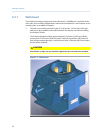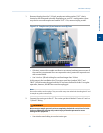
• All conduit fitting-threads, including factory-cut threads, must be coated with a
metal-bearing conducting grease prior to assembly.
• Temporarily cap the ends of all conduit runs immediately after installation to
prevent accumulation of water, dirt, or other contaminants. If necessary, swab out
conduits prior to installing the conductors.
• Install drain fittings at the lowest point in the conduit run; install seals at the point of
entry to the GC explosion-proof housing to prevent vapor passage and
accumulation of moisture.
• Use liquid-tight conduit fittings for conduits exposed to moisture.
When a conduit is installed in hazardous areas, follow these general precautions for
conduit installation:
• All conduit runs must have a fitting, which contains explosion-proof sealing
(potting) located within three inches from the conduit entrance to the explosion-
proof housing.
• The conduit installation must be vapor tight, with threaded hub fittings, sealed
conduit joints and gaskets on covers, or other approved vapor-tight conduit fittings.
WARNING!
Observe all precautionary signs posted on the equipment. Consult your company's policies and
procedures and other applicable documents to determine wiring and installation practices that
are appropriate for hazardous areas. Failure to do so may result in injury or death to personnel
or cause damage to the equipment.
3.3.5 Sample system requirements
Observe the following guidelines for installing GC sample systems:
Line Length If possible, avoid long sample lines. In case of a long sample line, flow veloci-
ty can be increased by decreasing downstream pressure and using by-pass
flow via a speed loop.
CAUTION!
Stream switching requires a sample pressure of 20 psig.
Sample Line Tubing
Material
• Use Silco tubing for H
2
S streams; for all other applications use stainless
steel tubing.
• Ensure tubing is clean and free of grease.
Installation and setup
36


















